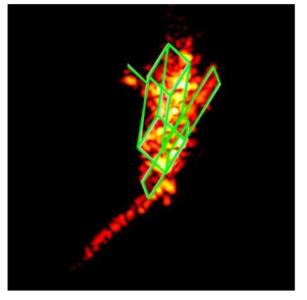Debris Attitude Motion Measurements and Modelling
Programme
GSTP
Programme Reference
G61C-034GR
Prime Contractor
ASTRONOMICAL INST. UNIV. OF BERN
Start Date
End Date
Status
Closed
Country
Switzerland

Objectives
Develop algorithms for the assessment of attitude states from terrestrial radar and optical data, the advancement of measurement techniques and the parallel development of 6 degree-of-freedom simulation of the attitude behaviour of complex bodies.The goal is to arrive at a setup that allows to predict by simulation models, analyse and verify (by measurements) the attitude motion of uncontrolled, large complex bodies.
Description
Today, there is little knowledge on the attitude state of decommissioned objects.Observational means have improved in the past years, but are still limited regarding accurate estimate of motion vector orientations and magnitude.Yet, such knowledge is essential for the preparation of a removal mission, since attitude motions above a few degree per second will not allow to use classical robotic capture mechanisms anymore. Hence, the attitude state of the target is a significant criterion for the selection of removal techniques.
The reason for tumbling motions of uncontrolled objects are twofold: firstly, a mismatch between the barycentre of the projected surface in flight direction (relevant for drag) from the centre of mass will cause a momentum. Secondly, internal components like reaction wheels and gyros or rotating disks might transfer momentum to the satellite body. Observations in the past (e.g. with the TIRA radar applying SAR techniques) have mainly concentrated on objects which were about to undergo an uncontrolled re-entry in the following days (UARS, Phobos-Grunt). In a few cases attitude rates of about 10 deg/s have been estimated. The altitudes observed and geometries of the bodies are, however, not representative for the envisaged removal targets. Generation of so-called light curves (i.e. evolution of the brightness of space objects in the visible region) with the help of optical telescopes (ZIMLAT, OGS) is a second promising measure to estimate attitude rates of targets in higher altitudes. Further laser ranging could be a promising means to identify varying offset of a reflective surface from the centre of mass ofthe parent body.
In all cases, techniques are needed to improve the resolution of the data and to fit geometric models into the measurements for an estimation of the attitude and to compensate aspect angle motions. In order to understand the effects that cause the attitude motion, simulation models are required. These models will have to accurately represent the spacecrafts geometry and moments of inertia as well as internal moving parts for a 6 degree of freedom numerical propagation to analyse the expected attitude evolution in preparation and in comparison to observational results.
The end goal of the activity, once the described technology is developed, is to apply it on selected candidate targets to provide a representative data set as input for the selection of removal technologies.
The technology will also be a valuable asset for the analysis of spacecraft contingency where the identification of the attitude motion is key element in the process.
The major technological achievements to be reached are:
- Advancement of radar and optical measurements (including Laser Ranging) for the sensing of spacecraft attitude states (SAR and light curves) in terms of temporal and geometric resolution as well as noise reduction.
- Advancement of algorithms and techniques to fit geometric models into the data to result at an increased accuracy in the domain of <1deg/s in estimating the attitude rate and <1deg in estimating the orientation of the motion vector.
- Development of 6 degree of freedom simulators and spacecraft geometry models also reflecting internal moving parts to predict attitude state evolution bybuilding on existing technologies (ANGARA, Scarab).
- Application of the techniques to provide a first representative screening of the attitude motion of selected removal targets in the respective altitudes.
Application Domain
Generic Technologies
Technology Domain
11 - Space Debris
Competence Domain
10-Astrodynamics, Space Debris and Space Environment
Keywords
32-Clean Space
Initial TRL
TRL 4
Target TRL
TRL 6
Achieved TRL
TRL 6
Public Document
Executive Summary
